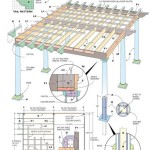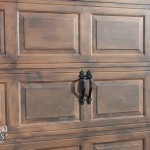How To Build Storage In Garage
The garage, often relegated to a mere parking space or a repository for discarded items, possesses significant potential as a valuable storage area. Optimizing garage space through strategic storage solutions enhances its functionality, decluttering living spaces and improving overall organization. This article provides a comprehensive guide to building effective storage systems within a garage environment, covering key considerations, construction techniques, and practical implementations.
Assessing Storage Needs and Garage Space
Before embarking on a storage construction project, a thorough assessment of storage requirements and available space is paramount. This involves a detailed inventory of items requiring storage, categorizing them based on size, weight, and frequency of use. Seasonal items, tools, sporting equipment, and automotive supplies each present unique storage challenges. Analyzing the garage's dimensions, including height, width, and depth, along with the location of existing features such as windows, doors, and electrical outlets, is crucial for determining optimal storage layouts.
Consider the following questions during the assessment phase:
- What types of items need to be stored (tools, seasonal decorations, automotive supplies, etc.)?
- What are the dimensions and weight of the largest and heaviest items?
- How frequently will these items be accessed?
- Are there any specific environmental considerations, such as moisture or temperature control?
Accurate measurements are essential. Create a scaled drawing of the garage, marking existing features and potential obstructions. This visual representation simplifies the planning process and helps identify areas suitable for different storage solutions. It is important to consider access points, such as the garage door and any pedestrian doors, ensuring adequate clearance and movement space.
Once the storage needs and spatial limitations are understood, the next step involves exploring different storage options and selecting those that best align with the identified requirements and the garage's layout.
Selecting Storage Solutions: A Range of Options
The market offers a diverse range of storage solutions, each suited to specific needs and garage configurations. Choosing the right solution depends on factors such as budget, skill level, desired aesthetic, and the type of items being stored. Some common and effective garage storage options include wall-mounted shelving, overhead storage racks, workbench systems, cabinet systems, and vertical storage solutions.
Wall-Mounted Shelving: This is a versatile and cost-effective option for storing a wide variety of items. Shelving can be constructed from various materials, including wood, metal, and plastic, and can be customized to fit specific dimensions. Heavy-duty shelving units are recommended for storing heavier items, such as tools and automotive parts. Wall-mounted shelving maximizes floor space and provides easy access to stored items. When installing shelving, ensure that it is securely anchored to wall studs to prevent collapse.
Overhead Storage Racks: These are ideal for storing seasonal items, holiday decorations, and other infrequently used belongings. Overhead storage racks utilize the often-underutilized space near the garage ceiling. They are particularly useful in garages with limited floor space. When installing overhead racks, ensure that the ceiling structure is strong enough to support the weight of the stored items. Professional installation is often recommended for safety reasons.
Workbench Systems: A workbench provides a dedicated space for repairs, projects, and hobbies. A well-designed workbench system includes ample work surface, storage drawers, cabinets, and pegboards for organizing tools. Consider the size and type of projects that will be undertaken to determine the appropriate workbench dimensions. A sturdy and durable workbench is essential for safe and efficient work.
Cabinet Systems: Garage cabinets offer a clean and organized storage solution, concealing items from view and protecting them from dust and moisture. Cabinets can be purchased pre-assembled or constructed from scratch. Metal cabinets are durable and resistant to rust and damage, while wood cabinets offer a more aesthetically pleasing appearance. Consider the overall aesthetic of the garage when selecting cabinet styles and finishes.
Vertical Storage Solutions: Maximizing vertical space is crucial in a garage environment. Vertical storage solutions include pegboards, slatwall systems, and tall cabinets. Pegboards are ideal for organizing tools and small parts, while slatwall systems provide a versatile platform for hanging a variety of items. Tall cabinets can store sporting equipment, gardening tools, and other long or bulky items.
Careful consideration of these storage options, tailored to the specific needs and spatial constraints of the garage, is essential for creating an effective and functional storage system.
Building and Installing Storage Systems: A Step-by-Step Guide
Once the storage solutions have been selected, the construction and installation process can begin. This requires careful planning, accurate measurements, and the use of appropriate tools and materials. Prior to construction, ensure that all necessary permits are obtained, if required by local regulations. Safety should be prioritized throughout the entire process, wearing appropriate personal protective equipment, such as safety glasses and gloves.
Wall-Mounted Shelving Installation:
- Locate wall studs using a stud finder.
- Mark the desired height and location of the shelving brackets.
- Pre-drill pilot holes into the wall studs.
- Attach the shelving brackets to the wall studs using appropriate screws.
- Place the shelving boards onto the brackets.
- Secure the shelving boards to the brackets using screws or nails.
Ensure the shelving is level using a spirit level. For heavier items, consider using additional brackets for added support.
Overhead Storage Rack Installation:
- Locate ceiling joists and determine their load-bearing capacity.
- Assemble the overhead storage rack according to the manufacturer's instructions.
- Attach the rack supports to the ceiling joists using appropriate hardware.
- Ensure the rack is securely fastened and level.
Professional installation is strongly recommended for overhead storage racks, as improper installation can pose a safety hazard.
Workbench Construction:
- Design the workbench according to desired dimensions and functionality.
- Gather necessary materials, including lumber, hardware, and finishing materials.
- Cut the lumber according to the design plans.
- Assemble the workbench frame using screws or nails.
- Attach the work surface to the frame.
- Install drawers, cabinets, and pegboards as desired.
- Sand and finish the workbench to protect the wood and enhance its appearance.
Consider adding a vise or other specialized tools to the workbench to increase its functionality.
Cabinet System Installation:
- Assemble the cabinets according to the manufacturer's instructions.
- Position the cabinets in the desired location.
- Level the cabinets using shims.
- Secure the cabinets to the wall using screws or bolts.
- Install doors and drawers.
- Adjust hinges and drawer slides as needed.
Ensure that the cabinets are securely anchored to the wall to prevent tipping.
Vertical Storage Installation:
- Install pegboards or slatwall systems according to the manufacturer's instructions.
- Attach hooks, shelves, and other accessories to the pegboard or slatwall.
- Position tall cabinets in the desired location and secure them to the wall.
Vertical storage solutions should be strategically placed to maximize accessibility and minimize clutter.
Throughout the construction and installation process, attention to detail and adherence to safety guidelines are paramount. Regular checks for levelness, secure fastening, and proper alignment ensure the longevity and safety of the storage systems.
By carefully assessing storage needs, selecting appropriate solutions, and following detailed construction and installation procedures, homeowners can transform their garages into well-organized and functional storage spaces, maximizing usable area and enhancing the overall value of their property.

How To Build Shelving In A Garage Three Ways Ana White

How To Build Diy Garage Shelving Young House Love

How To Build Diy Garage Storage Shelves Crafted Work

How To Build A Double Sided Mobile Storage Unit Start Finish

How To Build Sy Garage Shelves Home Improvement Stack Exchange Blog

Easy 2x4 Garage Shelves Diy Storage

How To Build Garage Shelves The Easy Way Infarrantly Creative

How To Build Sy Garage Shelves Home Improvement Stack Exchange Blog

Diy Garage Shelves Modern Builds

How To Build A Multipurpose Garage Storage Station Wilker Do S1
Related Posts








